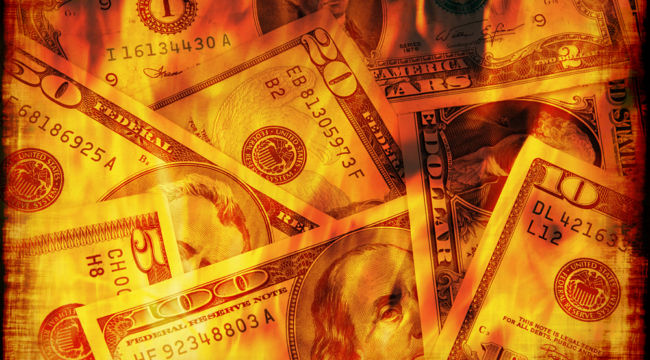Why the Economy Won’t Recover
We have spent the past two days contemplating the nature of money… and the international monetary system.
We hypothesized that there is no actual money in monetary policy. And that central banks are helpless giants, tissue paper tigers, all mush and milk.
We even vented the extravagant theory that a “shadow banking system” governs the global monetary system.
Today we sink deeper into the shadows… and widen our investigation of this twilit banking underworld.
Has the world failed to recover from the financial crisis… because the shadow banking system has failed to recover from the financial crisis?
This is the question we tackle today.
If you missed yesterday’s reckoning, we refer you here for background.
But in brief review…
The Shadow Banking System Supplied the World with Dollars
The major banks and their offshore divisions constitute the shadow banking system.
Across Europe, Asia, the Caribbean and elsewhere this shadow extends.
It first acquired existence in the 1950s, years after Bretton Woods enthroned the dollar king of the world.
It proliferated vast amounts of dollars independently of the United States banking system. These offshore dollars oiled the gears of international commerce.
Explains Jeffrey Snider, likely the world’s primary authority on the shadow banking system:
Through the 1960s, the [shadow banking] system created new U.S. dollar money supply out of thin air… with no backing by gold or by physical cash issued by the U.S. Treasury… The [shadow banking] system evolved outside of the Fed… [It was a] market operating entirely outside of the U.S. banking system and therefore without U.S. regulation…
The world needs dollars for the purposes of a global reserve currency. It gets them from this [shadow banking] system.
The Shadow Banking System: A Bubble Machine
Soaked in dollar liquidity, ultimately it emerged a parallel banking system. It operated independently of central banks… and without supervision.
The shadow banking system — not central banks — formed the invisible brick and mortar of the global monetary system.
By the early 2000s it grew fat, decadent, rich beyond avarice.
As suggested yesterday, the shadow banking system may have been the true culprit of the housing crisis.
That was largely owing to derivatives, credit swaps and other exotic financial instruments that detonated so gorgeously in 2008.
Snider:
The reason we got asset bubbles in both the stock market and the housing market in the United States was the fact that the [shadow banking] system was growing exponentially at those time periods. In other words, the shadow system was creating both the liquidity as well as the credit resources for those things to actually happen…
It was essentially a self-contained system that operated beyond the reach of everybody around the world…
All of this was taking place in a place that wasn’t supposed to exist. So it was an enormous hidden, misunderstood, misplaced banking system, misplaced monetary system, that was just waiting to be a big problem.
And it’s not coincidence… that we see this major inflection, especially in stocks and housing in the United States around 1995. Because that is when the [shadow banking] system… really started to fully mature into its final state…
And what we find is the derivative system, or the derivative part of the [shadow banking] system, going essentially parabolic in the 2000s. In other words, once all of these evolutions in money started coming together in the late ’90s and early 2000s, the system just took off on itself… By the time the Fed started to get a sense that something was awry it was already too late.
Then we come to 2008…
The Powerful Lesson of Bear Stearns
The shadow banking fell into a panicked delirium. All its derivatives and financial innovations became combustible gunpowder — attached to a rapidly burning fuse.
The system managed to withstand the worst of the blast — if barely.
But the collapse of Bear Stearns struck the fear of Almighty God into these shadow banks.
Again, Snider:
Bear wasn’t some subprime peddler, it was everyone. For the first time, liquidity risks had proven to be very real and immediate…
Prior it was believed by everyone to be riskless returns. Bear taught them, via global dollar liquidity, it had really been the reverse…
In other words, Bear’s final chapter… caused every single global [shadow] bank to really consider, most for the first time, what was actually at stake…
So the 2008 panic was very instructive in a way, because it showed banks the Fed had no idea what it was doing, and even if it did know what it was doing it was incapable of solving these problems… The liquidity lesson of Bear Stearns remains the overriding property of the global money system.
But 2011 was the true end of the line.
The Demise of the Shadow Banking System
2011 witnessed the eurozone debt crisis. And the shadow banks pulled in their oars as risk raced ahead of reward:
That point was driven home especially hard in 2011, when despite two QEs, the Fed had expanded the level of bank reserve in the system by $1.6 trillion to the middle of 2011, yet there was another liquidity even in that year… For banks in that position and time period, it was a huge wake-up call that shadow banking activities were enormously risky. In fact, they were so risky that it wasn’t worth the effort…
It really isn’t any mystery as to why [2011] was the final blow…
Even in the quantitative easings that happened afterward — whether it was in Europe or in the United States or even Japan — none of those really had much of an effect. Because once the [shadow banking] system started to fall apart there was no stopping it.
“No More Growth in Global Money, No More Global Growth. It’s That Simple”
The shadow system has never recovered. Neither has the economy.
Coincidence? No, says Snider:
The shadow system has been nothing but dysfunctional ever since, and so has the economy…
Banks have been studiously shrinking ever since, only a few like Goldman or Deutsche Bank “brave” (read: stupid) enough to wade back into those money dealing activities, only to get burned every time… The risk-takers are the outliers, and always regretful at that. What the [shadow] system gave the global economy (extraordinary lift), following 2011 it has taken it away (persistent drag)…
The [shadow bank’s] dollar is the world’s true reserve currency, therefore problems in it are going to be problems shared by the whole interconnected global economy… Banks have been shrinking their balance sheets. Therefore, to alleviate the monetary strain we need to get them increasing their balance sheets… The banks are broken and this worldwide economy needs them not to be… When global money was growing, the global economy was too. No more growth in global money, no more global growth. It’s that simple.
Can you expect the Federal Reserve to patch the system, to wrest some order from this lawless jungle?
Must we ask?:
The Federal Reserve Has No Answers
The Federal Reserve has no idea what it takes to fix the broken monetary system (they can’t even get the simplest part right)… All these central bankers did was prove they had, and have, no answers.
But why no fix? And why is the Federal Reserve so incurably botched?:
As far as economists are concerned, the U.S. economy is a closed system. In other words, it has its own money supply, there are trade linkages to foreign sources, but monetarily there isn’t supposed to be much transit between the U.S. and outside the U.S. [The shadow banking system is beyond] the orthodox framework of understanding how all of these things work…
Officials never saw it that way and still don’t; they were, and are, incapable of such a realization. Economies are, in the orthodox textbook, treated as closed systems. There is no global economy to a central banker…
But by 2016 the truth could no longer be denied…
By 2016, the Fed was forced to admit defeat. They had tried four different QEs that had no success. It didn’t create the inflation they thought it would, and therefore there was no inflation and no wage gain and no recovery, so they had to admit what most other people had finally figured out many years before, that there was never going to be a recovery…
The [shadow banking] system is no longer functioning…So the lack of a global recovery after the Great Recession is a monetary problem. And it’s one that the Federal Reserve, so long as it persists in believing that the United States is a closed system, and that the Federal Reserve is at the center of the U.S. money supply, will never be able to fix…
If after 11 years… you still haven’t gotten it right… what are the chances you ever will?
Indeed… what are the chances they ever will — get it right?
But if they don’t?
Fix the Banks or Prepare for Social and Political Upheaval
We’re kind of stuck in this disinflationary depression condition… Unless the monetary system is substantially reformed, I don’t think this will change… [The present system] is in fact heading in the wrong direction and the political and social order is slowly being taken down with it…
There has to be a breaking point where either the political system realizes the dangers inherent in that condition and actually responds favorably by taking hold of the [shadow banking] system [or] actually reforming it rather than trying to throw another QE into the mix.
Just so. But what Winston Churchill probably never said of Americans, we might say of the Federal Reserve:
“You can always count on the Americans to do the right thing after they have tried everything else.”
Prepare for more QE, followed by MMT once it fails.
Only the Lord knows what follows once that fails…
Regards,
Brian Maher
Managing editor, The Daily Reckoning



Comments: